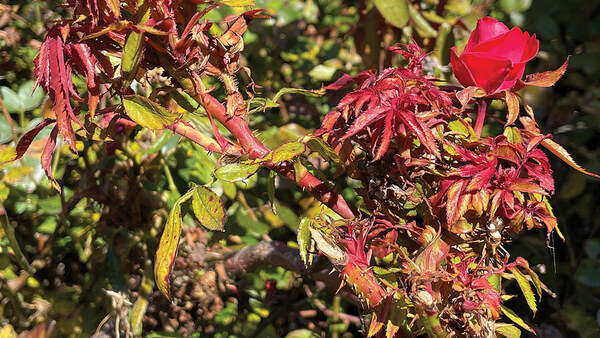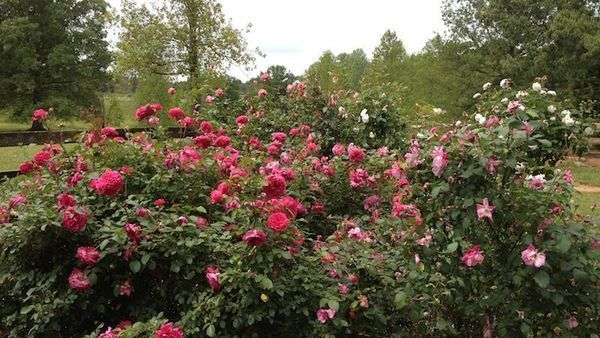
In our last blog post titled “Rose Rosette Disease – Are The Knock Out Roses To Blame“, we talked about the history of Rose Rosette Disease (RRD) and how it spreads. We also determined The Knock Out Roses were not to blame since RRD has been around long before they came on the scene.In this post I’d like to start getting more into the practical aspects of RRD. This week. Can you prevent it?
As mentioned in the previous post the first thing you need to do is see if there is any wild R. multiflora growing in your area. It is quite easy to recognize. First, generally it grows naturally as a climber or rambler. Look for a rose growing up a tree or into other shrubs. If it is growing on its own, look for something mounding with a loose growth habit. The foliage is a medium to lighter green. It is not the dark glossy foliage you see on many modern roses. The canes, when young, are quite pliable. They stiffen as they get older. A characteristic that makes it quite easy to recognize is most of the time it’s thornless. The blooms are small, white, with only five or so petals and they are fragrant. It blooms only in the spring so it’s important to learn to recognize the plant without the flowers.
If you do find any nearby, it’s best to eradicate it. Dig it up, destroy it; do whatever you have to do to get rid of it.

Since the disease is transmitted by small wind born mites, the other way to help prevent it is attempt to keep the mites out of your garden. You can buy miticides but they tend to be expensive. More affordable and environmentally friendly products like Horticultural Oils and insecticidal soaps will help. Mites tend to live on the underside of leaves so make sure to get up under the foliage. You can also periodically blast your leaves with a strong spray of water to knock them off.
I’ve used predatory mites in the past to control spider mites. I did some research on-line and found a paper by Marjorie Hoy from the Entomology and Nematology Department at the University of Florida. She essentially says the jury is still out if they will control the specific mite that transmits RRD. Personally, since bringing in beneficial insects is generally a good idea anyway, I think it couldn’t hurt. Generally you mail order predatory mites but creating a “Host Environment” as I discuss in my book Everyday Roses will help keep them around. Keep in mind predatory mites are susceptible to insecticidal soaps and horticultural oils so don’t use them once predatory mites are present.
Since mites and their eggs tend to live in new growth periodically trimming your roses can also help. I always do a summer trim anyway after the spring flowering flush to clean them up during summer and get ready for the fall flowering.
While none of these will totally prevent RRD in your garden, combined they will help keep it at bay. Also remember that attracting beneficials and doing a summer cleanup are good ideas regardless of the mite situation. R. multiflora is classified as a noxious weed in many parts of the country and eliminating it is also a good idea.
In the next post we’ll talk about what to do if a rose in your garden does get RRD.
Happy Roseing
Paul





















Comments
Log in or create an account to post a comment.
Sign up Log in